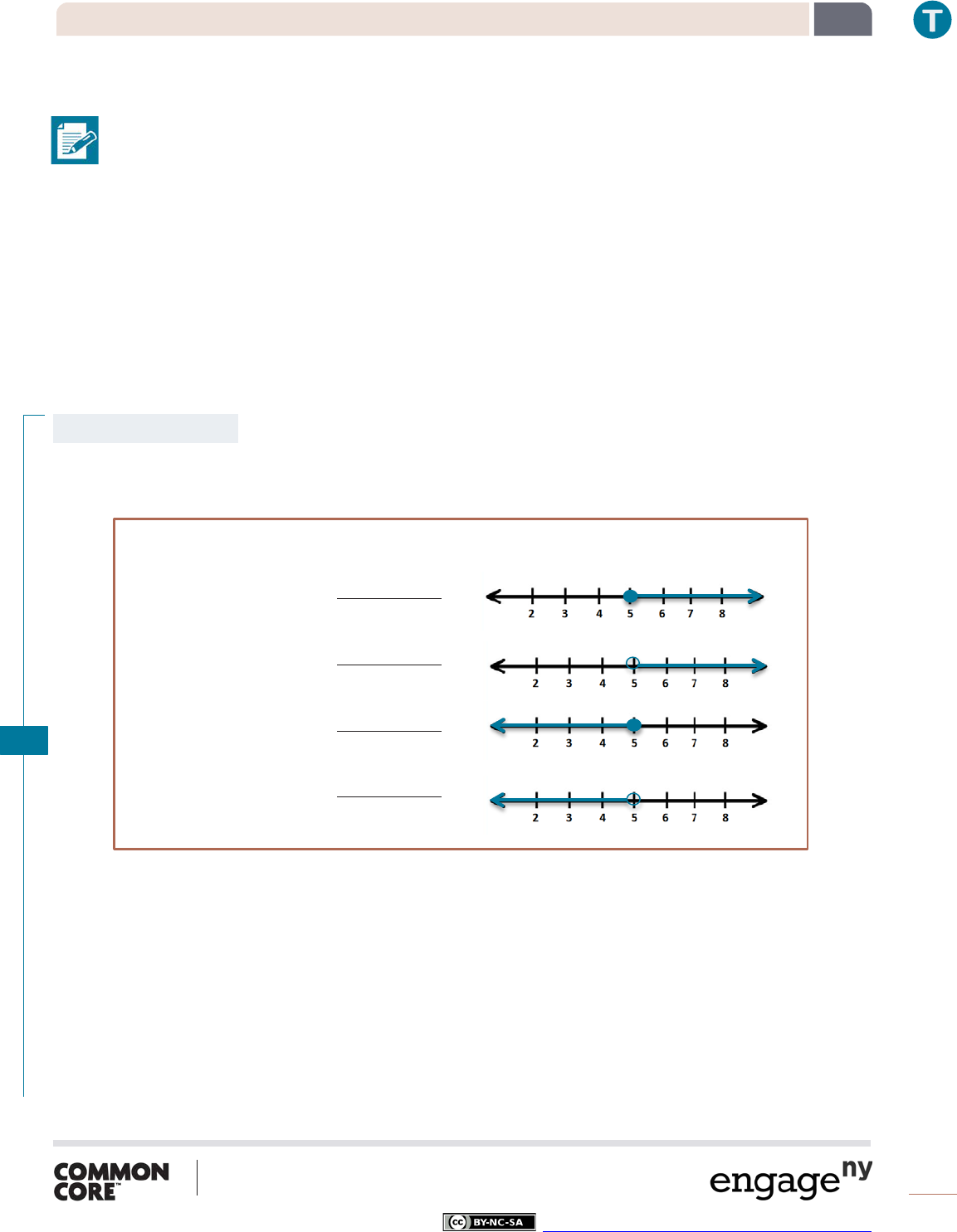
Lesson 34: Writing and Graphing Inequalities in Real-World Problems
Date:
11/19/14
371
© 2014 Common Core, Inc. Some rights reserved. commoncore.org
This work is licensed under a
Creative Commons Attribution-NonCommercial-ShareAlike 3.0 Unported License.
NYS COMMON CORE MATHEMATICS CURRICULUM
6•4
Lesson 34
Lesson 34: Writing and Graphing Inequalities in Real-World
Problems
Student Outcomes
Students recognize that inequalities of the form < and > , where is a variable and is a fixed number,
have infinitely many solutions when the values of come from a set of rational numbers.
Classwork
Example 1 (10 minutes)
Begin with a discussion of what each of these statements means. Have students share possible amounts of money that
could fit the given statement to build towards a graph and an inequality.
Example 1
Statement Inequality Graph
a. Caleb has at least $.
b. Tarek has more than $.
c. Vanessa has at most $.
d. Li Chen has less than $.
How much money could Caleb have?
He could have $5, $5.01, $5.90, $6, $7, $8, $9, …. More simply, he could have $5 or any amount
greater than $5.
How would we show this as an inequality?
≥ 5, where is the amount of money that Caleb has in dollars.
What numbers on the graph do we need to show as a solution?
5 is a solution and everything to the right.
Because we want to include 5 in the solution, we will draw a solid circle over the 5 and then an arrow to the
right to show that all the numbers 5 and greater are part of the solution.
>
≤
≥
<
MP.4
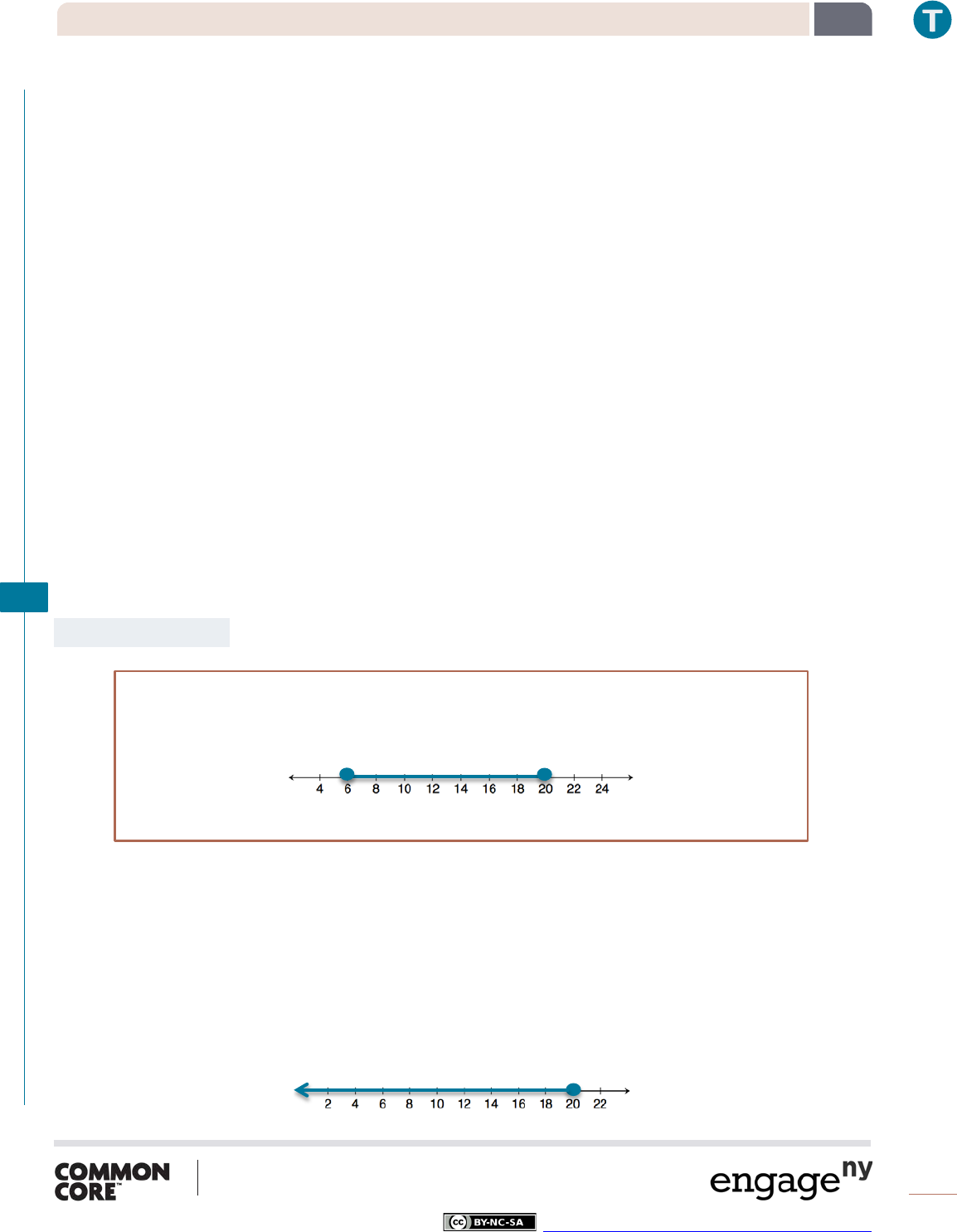
Lesson 34: Writing and Graphing Inequalities in Real-World Problems
Date:
11/19/14
372
© 2014 Common Core, Inc. Some rights reserved. commoncore.org
This work is licensed under a
Creative Commons Attribution-NonCommercial-ShareAlike 3.0 Unported License.
NYS COMMON CORE MATHEMATICS CURRICULUM
6•4
Lesson 34
How does the statement about Tarek differ from the statement about Caleb?
Tarek has more than $5, but he cannot have exactly $5, where Caleb might have had exactly $5.
So, how would we show this as an inequality?
> 5, where is the amount of money Tarek has in dollars.
When we graph the inequality for Tarek, we still want a circle on the 5, but this time it will not be solid to show
that 5 is not included in the solution.
What does “at most” mean in Vanessa’s example?
Vanessa could have $5, but no more than 5. So, she could have less than $5, including $4, $3, $2, $1,
$0, or even a negative amount if she owes someone money.
How would we write this as an inequality?
≤ 5, where is the amount of money Vanessa has in dollars.
How would you show this on the graph?
We would put a circle on the 5 and then an arrow towards the smaller numbers.
Would we have a solid or open circle?
It would be solid to show that 5 is part of the solution.
Would the inequality and graph for Li Chen be the same as Vanessa’s solution? Why or why not?
No, they would be similar but not exactly the same. Li Chen cannot have $5 exactly. So, the circle in
the graph would be open, and the inequality would be < 5, where represents the amount of money
Li Chen has in dollars.
Example 2 (5 minutes)
Example 2
Kelly works for Quick Oil Change. If customers have to wait longer than minutes for the oil change, the company does
not charge for the service. The fastest oil change that Kelly has ever done took minutes. Show the possible customer
wait times in which the company charges the customer.
≤ ≤
How is this example different from the problems in Example 1?
This one is giving a range of possible values. The number of minutes he takes to change the oil should
be somewhere between two values instead of greater than just one or less than just one.
Let’s start with the first bit of information. What does the second sentence of the problem tell us about the
wait times for paying customers?
The oil change must take 20 minutes or less.
How would we show this on a number line?
Because 20 minutes is part of the acceptable time limit, we will use a solid circle and shade to the left.
MP.4

Lesson 34: Writing and Graphing Inequalities in Real-World Problems
Date:
11/19/14
373
© 2014 Common Core, Inc. Some rights reserved. commoncore.org
This work is licensed under a
Creative Commons Attribution-NonCommercial-ShareAlike 3.0 Unported License.
NYS COMMON CORE MATHEMATICS CURRICULUM
6•4
Lesson 34
Now, let’s look at the other piece of information. The fastest Kelly has ever completed the oil change is 6
minutes. What does this mean about the amount of time it will take?
This means that it will take 6 minutes or more to complete an oil change.
How would we show this on a number line?
Because 6 minutes is a possible amount of time, we will use a solid circle. Then we will shade to the
right.
Now, we need to put both of these pieces of information together to make one model of the inequality.
How could we show both of these on one number line?
Instead of an arrow, we would have two circles and we would shade inbetween.
Should the circles be open or solid?
Because he has to change the oil in 20 minutes or less, the 20 is part of the solution and the circle will
be closed. The 6 minutes is also part of the solution because it is an actual time that Kelly has
completed the work. The circle at 6 should also be closed.
Example 3 (5 minutes)
Example 3
Gurnaz has been mowing lawns to save money for a concert. Gurnaz will need to work for at least six hours to save
enough money, but he must work fewer than hours this week. Write an inequality to represent this situation, and
then graph the solution.
≤ <
How would we represent Gurnaz working at least six hours?
“At least” tells us that Gurnaz must work 6 hours or more.
≥ 6
What inequality would we use to show that he must work fewer than 16 hours?
Fewer than means that Gurnaz cannot actually work 16 hours. So, we will use < 16.
Exercises 1–5 (15 minutes)
MP.4
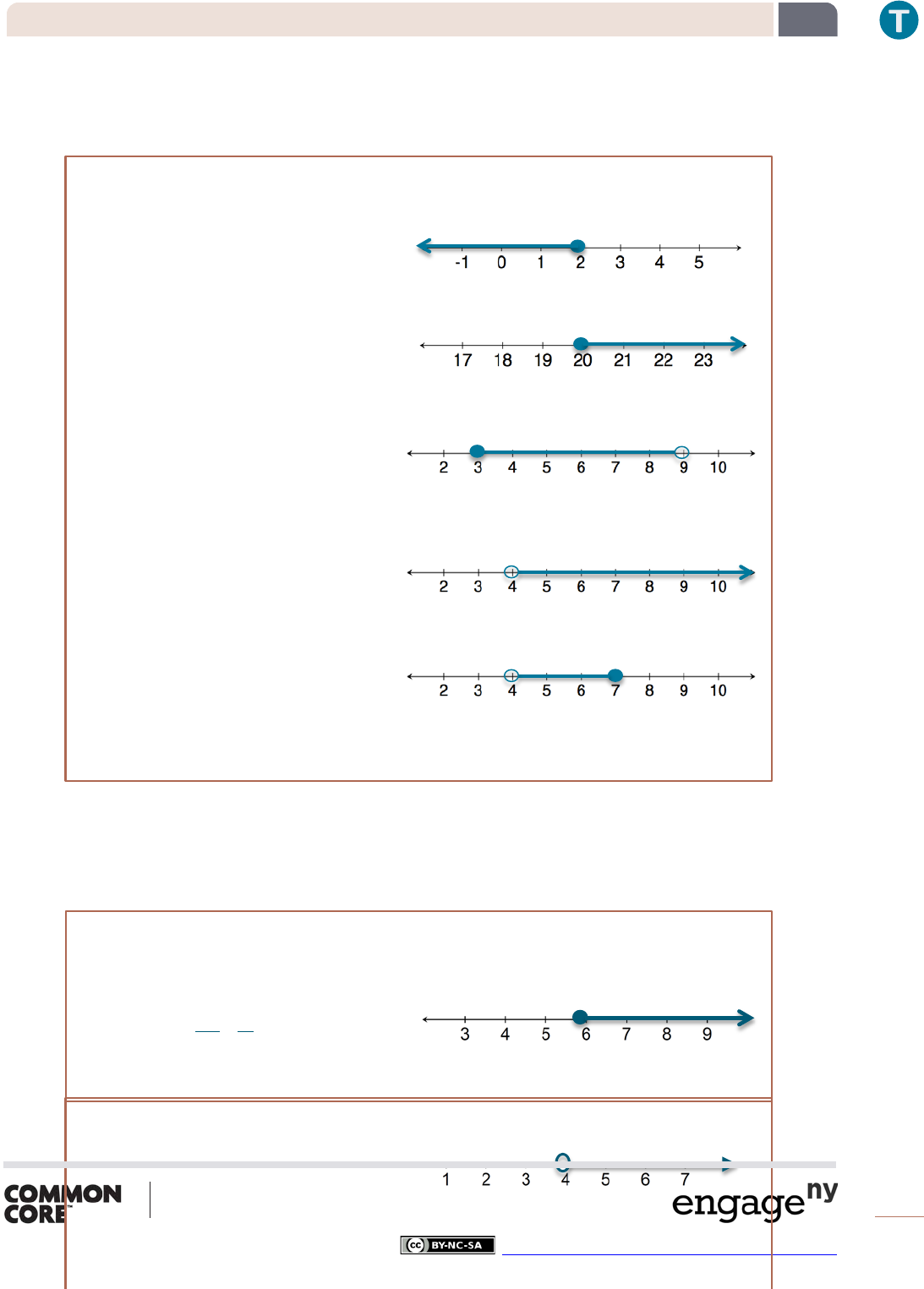
Lesson 34: Writing and Graphing Inequalities in Real-World Problems
Date:
11/19/14
374
© 2014 Common Core, Inc. Some rights reserved. commoncore.org
This work is licensed under a
Creative Commons Attribution-NonCommercial-ShareAlike 3.0 Unported License.
NYS COMMON CORE MATHEMATICS CURRICULUM
6•4
Lesson 34
Students work individually.
Exercises 1–5
Write an inequality to represent each situation. Then, graph the solution.
1. Blayton is at most meters above sea level.
≤ , where is Blayton’s position in relationship
to sea level in meters.
2. Edith must read for a minimum of minutes.
≥ , where is the number of minutes Edith
reads.
3. Travis milks his cows each morning. He has never gotten fewer than gallons of milk; however, he always gets
fewer than gallons of milk.
≤ < , where represents the gallons of
milk.
4. Rita can make cakes for a bakery each day. So far, she has orders for more than cakes. Right now, Rita needs
more than four days to make all cakes.
> , where is the number of days Rita has to
bake the cakes.
5. Rita must have all the orders placed right now done in days or fewer. How will this change your inequality and
your graph?
< ≤
Our inequality will change because there is a range for the number of days Rita has to bake the cakes. The graph
has changed because Rita is more limited in the amount of time she has to bake the cakes. Instead of the graph
showing any number larger than , the graph now has a solid circle at because Rita must be done baking the cakes
in a maximum of days.
Possible Extension Exercises 6–10
The following problems combine the skills used to solve equations in previous lessons within this module and
inequalities.
Possible Extension Exercises 6–10
6. Kasey has been mowing lawns to save up money for a concert. He earns $ per hour and needs at least $ to go
to the concert. How many hours should he mow?
≥
≥
≥
Kasey will need to mow for or more hours.
7. Rachel can make cakes for a bakery each day. So far, she has orders for more than cakes. How many days will
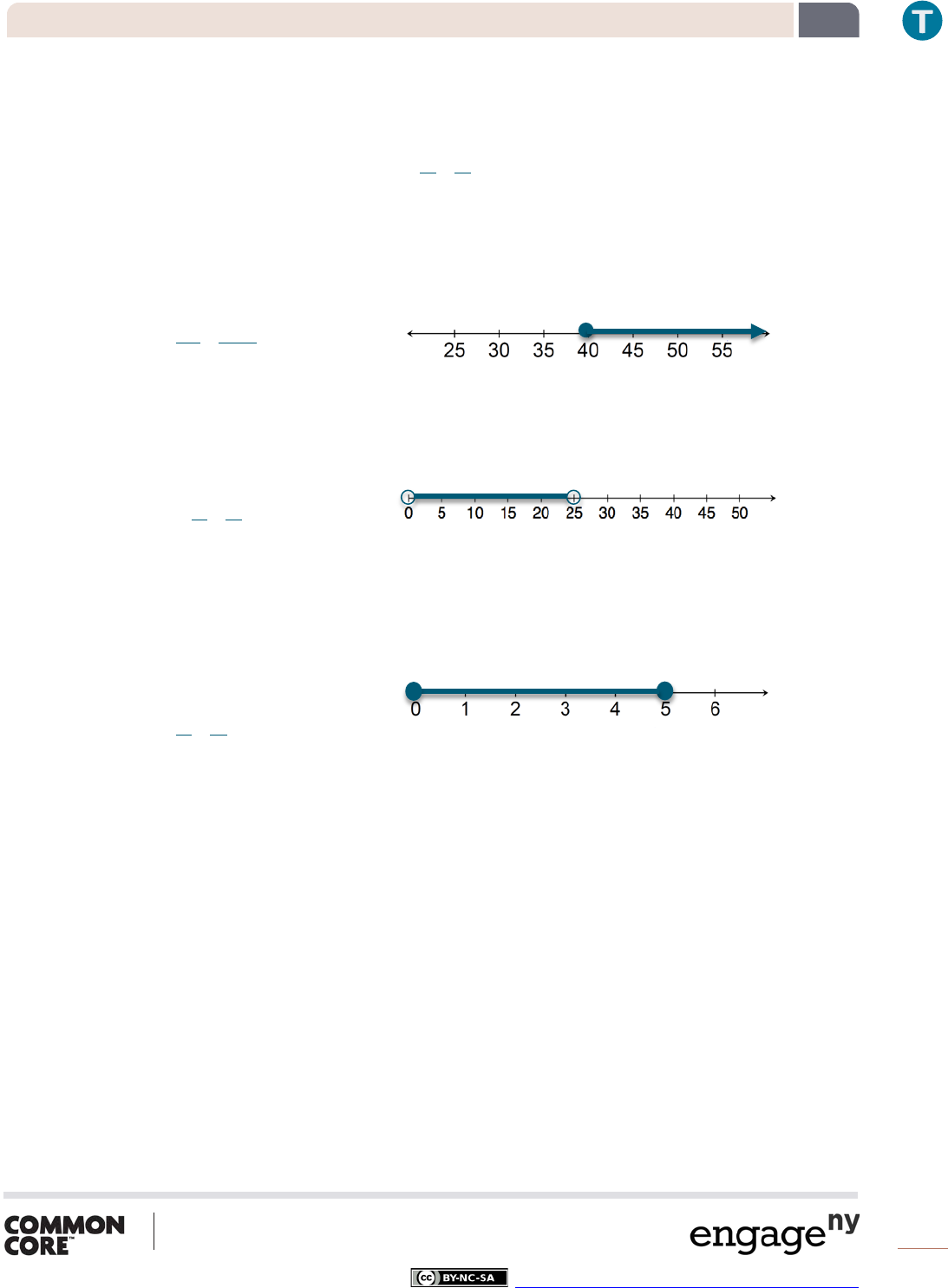
Lesson 34: Writing and Graphing Inequalities in Real-World Problems
Date:
11/19/14
375
© 2014 Common Core, Inc. Some rights reserved. commoncore.org
This work is licensed under a
Creative Commons Attribution-NonCommercial-ShareAlike 3.0 Unported License.
NYS COMMON CORE MATHEMATICS CURRICULUM
6•4
Lesson 34
it take her to complete the orders?
>
>
>
Rachel will need to work more than days.
8. Ranger saves $ each week. He needs to save at least $, to go on a trip to Europe. How many weeks will he
need to save?
≥ ,
≥
,
≥
Ranger needs to save for at least weeks.
9. Clara has less than $. She wants to buy pairs of shoes. What price shoes can Clara afford if all the shoes are the
same price?
<
<
<
Clara can afford shoes that are greater than $ and less than $.
10. A gym charges $ per month plus $ extra to swim in the pool for an hour. If a member only has $ to spend
each month, at most how many hours can the member swim?
+ ≤
+ − ≤ −
≤
≤
≤
The member can swim in the pool for hours. However, we also know that the total amount of time the member
spends in the pool must be greater than or equal to hours because the member may choose not to swim.
≤ ≤
Closing (5 minutes)
How are inequalities different from equations?
Inequalities can have a range of possible values that make the statement true, where equations do not.
Does the phrase “at most” refer to being less than or greater than something? Give an example to support
your answer.
At most means that you can have that amount or less than that amount. You cannot go over. My mom
says that I can watch at most 3 TV shows after I do my homework. This means that I can watch 3 or
fewer than 3 TV shows.
Exit Ticket (5 minutes)

Lesson 34: Writing and Graphing Inequalities in Real-World Problems
Date:
11/19/14
376
© 2014 Common Core, Inc. Some rights reserved. commoncore.org
This work is licensed under a
Creative Commons Attribution-NonCommercial-ShareAlike 3.0 Unported License.
NYS COMMON CORE MATHEMATICS CURRICULUM
6•4
Lesson 34
Name Date
Lesson 34: Writing and Graphing Inequalities in Real-World
Problems
Exit Ticket
For each question, write an inequality. Then, graph your solution.
1. Keisha needs to make at least 28 costumes for the school play. Since she can make 4 costumes each week, Keisha
plans to work on the costumes for at least 7 weeks.
2. If Keisha has to have the costumes complete in 10 weeks or fewer, how will our solution change?
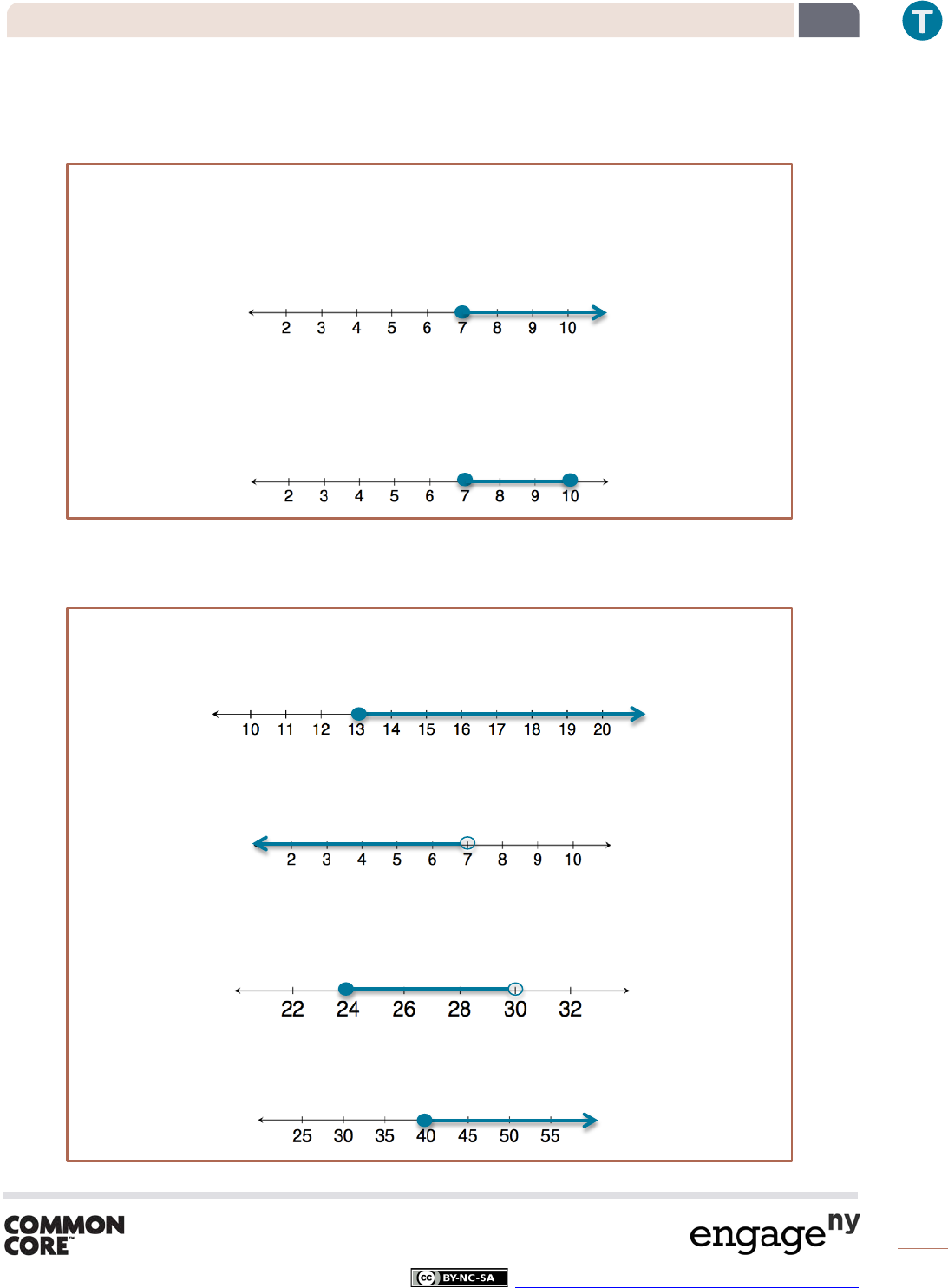
Lesson 34: Writing and Graphing Inequalities in Real-World Problems
Date:
11/19/14
377
© 2014 Common Core, Inc. Some rights reserved. commoncore.org
This work is licensed under a
Creative Commons Attribution-NonCommercial-ShareAlike 3.0 Unported License.
NYS COMMON CORE MATHEMATICS CURRICULUM
6•4
Lesson 34
Exit Ticket Sample Solutions
For each question, write an inequality. Then, graph your solution.
1. Keisha needs to make at least costumes for the school play. Since she can make costumes each week, Keisha
plans to work on the costumes for at least weeks.
≥
Keisha should plan to work on the costumes for or more weeks.
2. If Keisha has to have the costumes complete in weeks or fewer, how will our solution change?
Keisha had or more weeks in Problem . It will still take her at least weeks, but she cannot have more than
weeks.
≤ ≤
Problem Set Sample Solutions
Write and graph an inequality for each problem.
1. At least .
≥
2. Less than .
<
3. Chad will need at least minutes to complete the K race. However, he wants to finish in under minutes.
≤ <
4. Eva saves $ each week. Since she needs to save at least $, to go on a trip to Europe, she will need to save
for at least weeks.
≥
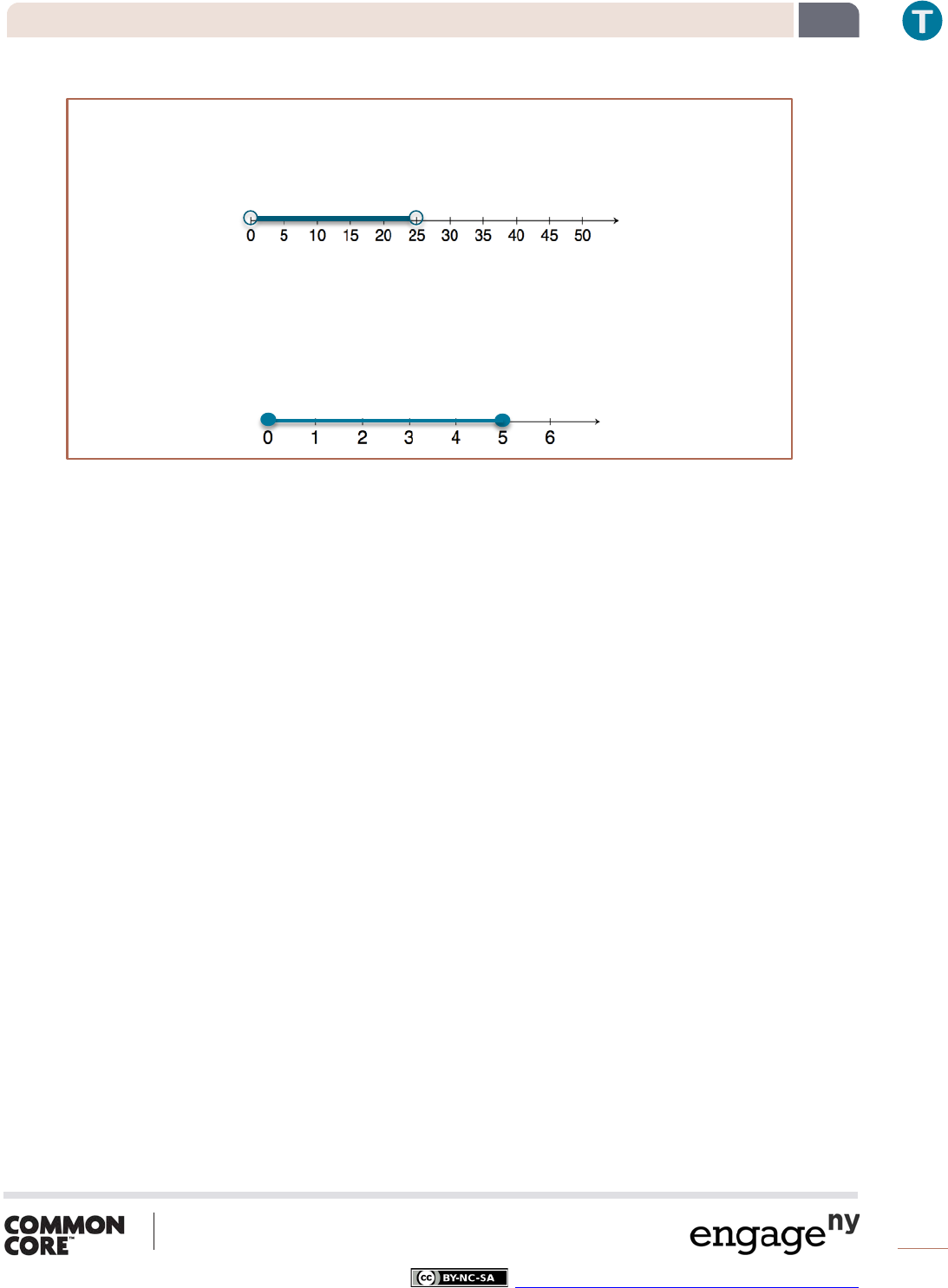
Lesson 34: Writing and Graphing Inequalities in Real-World Problems
Date:
11/19/14
378
© 2014 Common Core, Inc. Some rights reserved. commoncore.org
This work is licensed under a
Creative Commons Attribution-NonCommercial-ShareAlike 3.0 Unported License.
NYS COMMON CORE MATHEMATICS CURRICULUM
6•4
Lesson 34
5. Clara has $. She wants to buy pairs of the same pants. Due to tax, Clara can afford pants that are less than
$.
Clara must spend less than $, but we also know that Clara will spend more than $ when she buys pants at the
store.
< <
6. A gym charges $ per month plus $ extra to swim in the pool for an hour. Because a member has just $ to
spend at the gym each month, the member can swim at most hours.
The member can swim in the pool for hours. However, we also know that the total amount of time the member
spends in the pool must be greater than or equal to hours because the member may choose not to swim.
≤ ≤
